PREMISE - GEOGRAPHY & POLITICS - MAJOR EVENTS - FORUMS & JOIN
Most of the world is divided between the three Great Powers. Russia has the largest empire in terms of land, closly followed by the British Empire. However, China has the highest population (more than a billion of the world's four billion people). Britain has the second highest population, a great deal of it concentrated in India.
On the map below, the British Empire is coloured red, the Russian Empire purple, and the Chinese Empire green. The North European Union is coloured blue, the Dominion of Mexico lighter-grey, the Kingdom of Colombia darker-drey, and the Empire of Brazil lighter-green. Click on the map for a larger image.
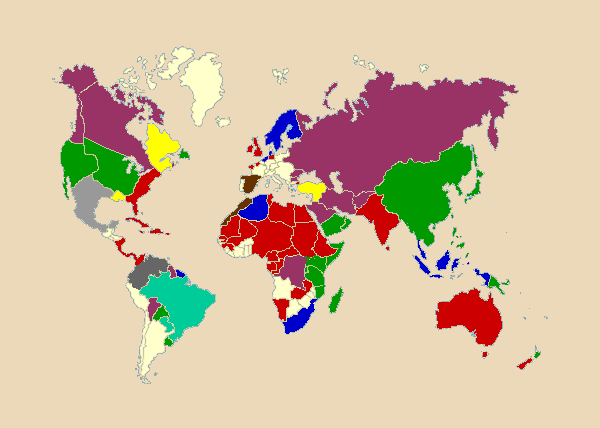
The BRITISH EMPIRE
Head
of State: King Jonathan of Hanover
Prime Minister: Admiral (ret.) James Crest
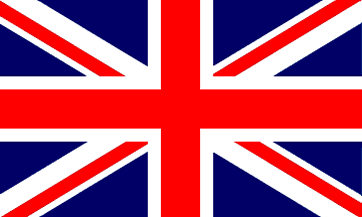
The capital of the British Empire is London, from which the British Royal Family, the House of Hanover, rules.
Other major cities are New York City, Boston, Philadelphia, Bombay, Sydney, and Cairo.
During the 19th century, democracy grew in the empire, although less so than in
the real world, being limited partly because of the way society, the monarchy
and the government evolved during that time. The higher social classes
practically make up the government, as they are the only people that vote for
elections. The lower social classes are by law allowed to vote, but they are
socially not expected to involve in politics. Since 1864, also woman of the
higher social classes are allowed to vote.
There are three main political parties in the Empire:
- The Conservative Party. This is the party of the nobility and landowners. They favour
industry, but also government keeping it hands off industry, allowing it to sink
or swim on its own. As such things like trade unionism should be banned and the
welfare state used to keep people working, via institutions such as the
workhouse. Government should focus on a strong foreign policy, internal order,
and allowing the economy to work as efficiently as possible via minimal
interference.
- The Liberal Party. The Liberal Party believes that
there should be a welfare state to protect people, and other organisations such
a trade unions to protect workers rights, but also that people should be able to
work to improve themselves within that framework. So while the government should
have some influence in the economy it should also still be free to be used by
people to improve themselves. Toleration and social improvement are important
for them.
- The Social-Democratic Party. The real-world Labour Party closely resembles the
social-democrats. They share some views with the Liberals. That is, they believe in
the welfare state, trade unions and so on, but they tend to view the economy as
something the government should control via central planning for the good of
all, redistributing wealth and jobs as required for the good of the nation as a
whole. Toleration and social improvement, while important, are not as important
as improving the lot of as many people as possible.
All of the regions of the British Empire which are considered 'ready' have what
are known as Union governments. These grew out of Benjamin Franklin's Plan of
Union put forward, and accepted, at the Albany Congress in 1754. Each region of
the Empire with such a government is administered by a Crown-appointed
President-General and a General Council of delegates from the region in
question. It has exclusive control of local affairs, including relations with
native peoples and the acquisition of land for the Crown, and is responsible for
the defence of the region. Each of the regions of the Empire send
representatives to Parliament in London. As such the Empire is ruled for the
Empire, not for the British Isles alone. Areas which are not yet considered
ready for Union government are run by District Officers, who have a staff of
trained locals and ex-pats, and a larger staff of workers under them.
British North America is quite different to real-world America. There have not
been huge waves of immigration from Europe into America, though there has been
some. There has been a good deal of immigration from other sources, particularly
the Indian sub-continent. Because of this British North America is, ethnically,
a mix of mainly British (the Anglo-Saxon type), French (from the old French
colonies), Indian (from the sub-continent) and Native American with some
Spanish, Chinese and Russian thrown in for good measure. Because of the Indian
and Chinese influence there are, in some places, lots of Hindu, Sikh, Buddhist
and other temples.
Indian Territory and Mountain Territory are two regions within British North
America run by and for the Native Americans with their own Union governments. As
such they were, originally, Indian-only areas where non-Natives were not allowed
to settle except at trading towns along major transportation routes,
particularly the railways. Although there has been a good deal of mixing over
time, and the adoption of European technology, these two regions still retain a
largely Native American character.
(Seeing as the British Prime Minister is a retired navy Admiral, the defense leans ever so slightly towards a navy as opposed to a land army.)
In 1905, the British Empire ruled the following territories: England, Whales, Scotland, Ireland, Calais (France), Brittany (France), Hanover (Germany), Gibraltar (Spain), Corsica, Egypt, Libya, most of the Sahara, Arabia, India, Philippines, Australia, British Guinea, Canada, and most of the eastern US.
During the second World War of 1905-1920, Britain lost Canada, its central North America colonies, the Indian territories, and Arabia to the Chinese/Russian alliance. However, in a combined NEU-attack on the Russian western Sahara colony, it did regain control over all of northern Africa.
The RUSSIAN EMPIRE
Head of State: Tsarina Catherine III
Premier: Obram Vladek
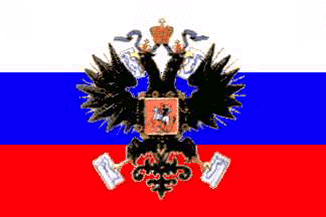
Russia's capital is St. Petersburg, from which the Romanov Dynasty still rules.
The current czar is Tsarina Catherine III, former wife of Czar Nicholas.
In Russia, the balance of power is further towards the monarch. There is an
elected parliament, the Imperial Duma, but the Czar is the final authority. As
part of this, each region of the Russian Empire has a local government which
rules on local affairs, with a governor who rules for the Czar, not dissimilar
to the Union governments of the British Empire.
Russia's political parties, who meet in the Imperial Duma, are as followed:
- The Old Nobility. The Boyars; the party of landowners, they tend to be
conservative; they blur with the New Nobility.
- The New Nobility. They have similar views to the Old Nobility, but tend to be
more progressive than them; they blur with the Old Nobility.
- The Industrial Progress Party. Industrialists, whose policies tend to put
money and industry over people.
- The Church Socialist's Party. They wish to make society more egalitarian, and
eliminate poverty.
- The Military and Veterans. For a strong Russia and a strong military. They
tend to be conservative, and sometimes even reactionary.
- The Socialists Party. Founded directly following the World War, they fight for
more rights and welfare for the proletarian class.
In 1905, the Russian Empire ruled the following territories: Asia (except
for China, India, the Ottoman Empire, and Arabia),
Finland, Alaska, and West-Sahara.
During the second World War of 1905-1920, Russia and China conquered most of North America, including Canada, the British central North American colonies, and the Indian territories, and also gained control over Arabia. However, they lost their western Sahara colony to the British alliance, and Finland to the NEU.
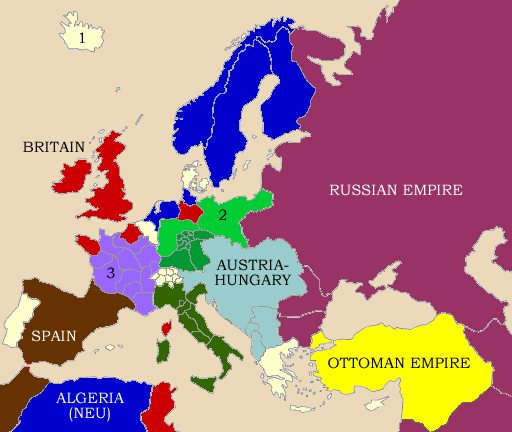
The
AUSTRO-HUNGARIAN EMPIRE
Head of State: Franz Joseph of Habsburg-Lorraine, Emperor of Austria, King of
Hungary
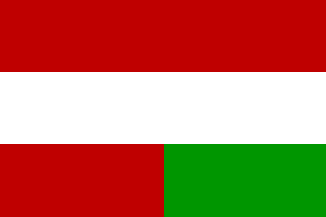
Austria-Hungary, also knows as the Dual Monarchy of the Habsburg Empire, is a dualistic state, in which the kingdom of Hungary enjoys self-government and proportional representation in joint affairs (principally foreign relations and defence) with the western and northern lands of the Austrian Empire under the Emperors of the Habsburg Dynastry, ruling from the capital of Vienna. The full name of the federation is "The Kingdoms and Lands Represented in the Imperial Council and the Lands of the Holy Hungarian Stephen's Crown".
Austria-Hungary has been established bya compromise between the Hungarian nobility and the Habsburg monarchy in an attempt ot maintain the old Austrian Empire. It is a multi-national Empire, and its political life is dominated by disputes between the eleven principal national groups. Although the Empire is frequently upset by quarelling between the groups, it has saw rapid economic growth and modernization throughout its history, as well as many liberal reforms.
The KINGDOM OF PRUSSIA
Head of State: King Frederick III of Prussia
Prime Minister: Otto von Bismarck
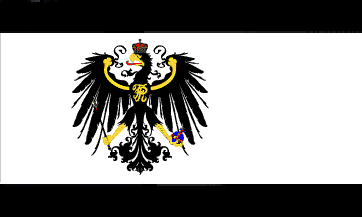
The Kingdom of Prussia exists since 1701, and is the leading kingdom of all German station, comprising in its current form almost two-third of the area that is referred to as "Germany".
In 1688, Frederick William I, the Great Elector, died, and his possessions passed to his son Frederick III (1688-1701), who became Frederick I of Prussia (1701-1713). With the exception of Prussia proper, all of Brandenburg's lands were a part of the Holy Roman Empire, by this time under the all but hereditary nominal rule of the house of Habsburg. Since there was only one King of the Germans within the Empire, Frederick gained the assent of the Emperor Leopod I to his adoption of the title of "King in Prussia", based on his non-Imperial territories, and the title came into general acceptance with the Treaty of Utrecht (1713).
In 1740, Frederick II, Frederick the Great, came to the throne, and invaded Silesia, an Austrian province, which was in turmoil after the death of Emperor Charles VI. After rapidly occupying Silesia, Frederick offered to protect new Austrian Archduchess, Maria Theresa, if the province were turned over to him. The offer was rejected, but Austria faced several other opponents, and Frederick was eventually able to gain formal cession with the Treaty of Berlin (1742).
To the surprise of many, Austria managed to renew the war successfully, and in 1744 Frederick invaded again to forestall reprisals and to claim, this time, the province of Bohemia. This time he failed, but French pressure on Austria's ally Britain led to a series of treaties and compromises (culminating in the 1748 Treaty of Aix-la-Chapelle that restored peace and left Prussia still in possession of Silesia).
Humiliated by the cession of Silesia, Austria worked to secure an alliance with France and Russia, while Prussia drifted into the United Kingdom's camp (the "Diplomatic Revolution"). When Frederick pre-emptively invaded Saxony and Bohemia over the course of a few months in 1756-1757, a general conflict broke out: the Seven Years' War.
This war was a desperate struggle for the Prussians, and the fact that they managed to fight much of Europe to a draw bears witness to Frederick's military skill. Facing Austria, Russia, France and Sweden simultaneously, and with only Hanover (and the non-continental British) as notable allies, he managed to hold off serious invasion until October 1760, when the Russian army briefly occupied Berlin and Königsberg. The situation became progressively grimmer, however, until the death of the Tsarina Elizabeth and the accession of the prussophile Peter III relieved the pressure on the eastern front. Sweden also dropped out of the war at about the same time.
Defeating the Austrian army at the Battle of Burkersdorf, and relying on continuing British success against France in the war's colonial theatres, Prussia was finally able to force a status quo ante bellum on the continent. This result confirmed Prussia's major role in Germany and Europe as a whole. Frederick, appalled by the near-miss for his country, lived out his days as a much more peaceable ruler.
The CHINESE EMPIRE
Head of State: Emperor Chen Wu Long

The capital of China is Beijing, where the Emperor rules from the Forbidden City. In China, the balance of power is biased even further towards the monarch than in the other Great Powers.
The law and government of the Chinese Empire is based upon the system of Collective Responsibility, which is rooted in the teachings of Confucius. Under this system groups of families are mutually responsible for each others good behaviour and share each others punishments for bad behaviour. Households are organised into groups of ten. Each household sends a representative - who can be male or female - to the monthly meeting of its group, and each such group elects a leader to represent it at the level of government above it. The head of each group is responsible to the level above it for the conduct of all members of their group. This is known as the 'bao jia' (tithing) system.
The bao jia system serves as an extension of the central government. It is the means by which taxation is levied on the populace, and also the means by which welfare and other such things are distributed to the population as they require it. Of course, being run by people the bao jia system is not perfect. As such, there is a large corps of Inspectors, a branch of the Civil Service, who work to enforce the proper running of the system.
With the increased democratisation of the Chinese Empire, and particularly the formation of the constitutional monarchy in 1960, the bao jia system provides a means by which representatives of the people are selected upwards from the mass of the Chinese people and sent to the elected parliament, the Grand Council, in Beijing.
Although China does effectively have the full franchise, membership of the Grand Council remains, in practise if not in law, limited to the upper levels of society, and in particular to members of the progressive School of Practical Learning (SPL). As such the nobility, the SPL and the Civil Service essentially run the country, with one of the former powers in the Chinese Empire, the Imperial Household Department, having been much reduced over the years.

There are no official political parties in the Chinese Empire. However, informal groups of people who share common interests perform a similar function.
The Chinese Empire has a different administrative process and a rather younger history of democracy than the other two Great Powers. The bao jia system used there provides as much of a democratised system as seems to be required, and also provides a mechanism by which the state can call up troops in time of need. It is also the means by which Chinese National Service is administered.
Although China is a progressive nation, because of its lack of democratisation the Empire is still mainly ruled for China as a whole rather than the Empire as a whole. As such, the various Chinese colonies around the world are ruled in the same way as the internal regions of China. That is, in each one the central government structure is copied, and the region is run by an organisation consisting of three commissions, one civil, one military, and one for surveillance.
China is also quite socially stratified. However, the exams for civil service entry are open to anyone, and schooling is universal, so anyone can rise up the ranks from humble beginnings, even into the nobility, the Grand Council, or the SPL. China's attitude to colonisation and the outside world has varied somewhat with time; it has a definite tendency towards isolationism, but as the Golden Emperor showed it is wise to look outwards, this has never been total.
As part of the reforms of the Chinese system that made it one of the three great powers of the world, Chinese criminal law was codified into a set of written laws, greatly restricting the flexibility magistrates could exercise during trials. The accused were granted some rights, some protection from 'unnecessary' torture, and were not allowed to be jailed for long periods while awaiting trial. The Emperor, particularly the later Emperors, did what was necessary to make the courts as appealing as possible, stressing the rule of law over their own moral influence, and working to minimise the loss of face and fear involved in making an appearance in court.
In 1905, the Chinese Empire ruled the following territories: China (including Mongolia and Tibet), Korea, Japan, Chinese Guinea, Chinese East Africa, Madagaskar, western United States (California, Nevada, Oregon, Idaho, Utah, Arizona).
During the second World War of 1905-1920, China pushed Britain out of the Philippines, and in a combined attack, invaded the North American continent, gaining control over the British central North America colonies and the Indian territories.
The NOORD
EUROPESE UNIE (North European Union)
Official Head of State: Queen Wilhelmina of Orange-Nassau
Premier (and de facto head of state):
Christoffer Ottenson
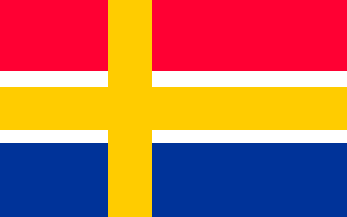
Of the lesser powers and nations, only the North-European Union (the NEU) is a
true representative democracy, with a largely powerless Royal Family,
amalgamated from those of the nations which make up the NEU. Even the NEUs
democracy has its problems, as the many industrial concerns in the NEU attempt
to manipulate the people and thus the government to their own ends.
The states of the NEU are held together by strong mutual self-protection links -
they have to compete or they will be swamped by the Great Powers. They excel at
high technology and niche markets. They still have patronymic surnames (that is,
the surname of a person is the first name of their father)
[as this was something imposed by Napoleon (in
Holland) and which were introduced in 1900 (in Sweden)].
The NEU operates a pseudo-socialistic governmental system known as 'poldermorality',
which has also been adopted in some other nations around the world. This
involves levelling society and job-sharing.
There are over 20 political parties in the NEU. There are, however, only nine
parties with seats in Parliament, and only five with seats in the Senate.
- The Liberal-Democratic Party: The largest party originated from the Dutch
left-liberal political group. The Liberal-Democrats strive for self-government
in personal matters and central decision-making on economics. They want the
government to serve the disadvantages in the name of fairness. They tolerate
social diversity, but work for economical equality.
- The Social-Democratic Party: Originated from the socialists political
tendency, they want the government to advance society and individuals through
expert central planning. They often doubt whether self-government is practical.
- The Democratic Party: The Democratic Party is a party of Libertarians. They
are self-governors in both personal and economic matters. Libertarians believe
the government's only purpose is to protect people from coercion and violence.
They value individual responsibility, and tolerate economic and social
diversity.
- The Centrists Party: They favour selective government intervention and
emphasize practical solutions to current problems. Centrists tend to keep an
open mind on new issues. Many centrists feel that government serves as a check
on excessive liberty.
- The Monarchists Party: The Monarchists strives for more influence of the
monarchy in government matters. They prefer self-government on economic issues,
but want official standards in personal matters. They want the government to
defend the community from threats to its moral fibre.
The capital of the NEU is at Den Haag (the Hague), which is the home of the
Queen, Premier, and the NEU government. Den Haag was the first city in the world
to have an elevated railway system providing public transport for its
inhabitants.
Other important cities include Amsterdam, Rotterdam, Oslo, Bergen, Stockholm,
Batavia, Paramaribo, and Cape Town.
In 1905, the NEU ruled the following territories: The Netherlands,
Sweden, Norway, Schleswig-Holstein, Algeria, Congo, South-Africa, Indonesia,
Guyana, Suriname, Bolivia. (The NEU lost control over Belgium in 1830, when it
succesfully seperated itself from The Netherlands. However, it did remain in
control over Belgium's Congo colony.)
During the second World War of 1905-1920, the NEU conquered Finland on the Russians, and in a combined British attack, invaded the Russian western Sahara colony. However, it lost Congo to the Chinese/Russian alliance.
La REPUBLIQUE DU NOUVELLE FRANCE (The Republic of New France)
President: Jean-Paul Beliveau
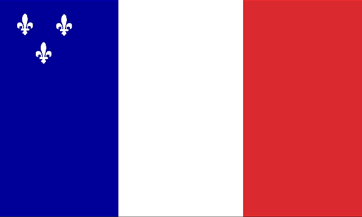
Nouvelle France, the diminished colony of France, consists of the Quebec
territory, Louisiana, and parts of the Mississippi Valley. Now independent from
France, the government is largely British-inspired, a more simplified version of
the French system.
With the enraging loss of the Acadian colonies (southern Nova Scotia and parts
of New Bruinswick), it is difficult to deal with the powerful British, who think
nothing of their French neighbours.
The largest cities are the capital of Quebec, and the cities of Montreal,
Nouvelle Orleans, and La Port Orleans; a shipping port to Newfoundland.
Political parties include La Bloc Quebecois, a strongly patriotic party in
power, Les Democrats Progressives, a modern party which stresses international
relations, and La Union Nord Amerique, which suggests an amalgamation of Britain
and Nouvelle France.
Nouvelle Orleans and nearby forts mean the French control the lucrative
Mississippi Delta. A strong presence along La St. Laurent means excellent access
to goods being shipped into Ontario. The primary resources of Nouvelle France
are fish, cattle, wood (highly sought after from the British in the lower
Americas), furs and clothing, and some small deposits of minerals. The cities
are quite industrialized, thanks to uneasy but extensive trade with the British.
During the second World War of 1905-1920, Nouvelle France expanded its Louisiana/Mississipi territory, and also conquered territory in the north on the British Albany Union.
The ALBANY UNION
President-General: Peter Whitefield
The Albany Union came about at a meeting when Benjamin Franklin proposed The Albany Plan of Union; a plan for the 'voluntary' union of the thirteen British colonies in North America into a Union which would be administered by a Crown-appointed President-General and a General Council of delegates from the colonies. It has exclusive control of Indian affairs, regulating Indian trade and buying Indian land for the Crown. It is also responsible for constructing forts and paying for troops to man them.
The capital of the Albany Union is Philadelphia. There are three main political parties:
- The Conservative Party: They wish to maintain close ties to the Crown, and favour a strong military;
- The People's Party: This party wants ties to the Crown, but not as much as the Conservatives. They would prefer to let the Crown appoint the President-General, but handle local affairs themselves;
- The Freedom Party: They favour absolute independence from the British Empire, nothing less.
In 1905, the Albany Union was comprised of the thirteen colonies in eastern America. The state of Florida was bought from Spain.
During the second World War of 1905-1920, the Albany Union lost some of its territory in the north to Nouvelle France.
The DOMINION OF MEXICO
Chief of
State: Emperor Carlo Rodrigues de Aragon III (ceremonial title)
Head of Government: President Miguel Diaz (ineffectual puppet)
'power behind the throne': Generalissimo Raul Zapata
The Capital City of Mexico was moved to Monterrey after
the troubles of 1878 and has remained there ever since.
The other major cities of the Dominion of Mexico are Laredo, Cuidad Juarez,
Tijuana, Chihuahua, Topolobampo, Mazatlan, San Luis Potosi, Tuxpan, Mexico City,
Guadalajara, Acapulco, Salina Cruz, Cancun, and Amarillo.
While Mexico has enjoyed relative freedom as a republic, during the last few
decades these freedoms have been slowly eroding as the military exerts greater
control over the elected officials.
Political parties in Mexico:
- The Workers and Peasants Communist Party: Banned since
the troubles of 1878, it still exists as an underground movement.
- Marxist Purity Party: Disdainful of the Workers and Peasants Communist Party
as being a corruption of Marx's ideals, this party has never really had any
substantial following outside of universities. It has yet to ever win an
election.
- United Socialist Part: A relatively new concept in politics, the welfare
state, has gained a foothold in Mexican politics. Gaining popularity with the
poor who are turned off by the more extreme communist parties, the Socialist
Party made a decent showing in the latest elections, capturing 12% of the
legislature and 3 governorships.
- Montezuma Nationalist Party: A banned racial purity party whose goal is the
re-establishment of the ancient native empires and eradication of the ruling
elite class which is typically composed of persons of Spanish ancestry. It has a
miniscule following as its violent themes turn off the devoutly Catholic
peasantry. Unfortunately, what it lacks in membership, it makes up for in
violent acts against government officials and buildings.
- Chamber of Commerce Party: Nothing more than a front for businesses to back
candidates known to favor a lazzie-faire approach to economics. Along with the
Socialist Party, they claim roughly 10-15% of any election.
- Monarchist/Republican Party: One of the two major parties in Mexico. Loyal to
the Emperor, they tend to split the remaining Governorships and Legislative
slots with the other major party. The current President, Miguel Diaz, is a
member of this party.
- Reformist Party: Believing a monarchy to be outmoded, though not endorsing
revolution, the Reformist Party works within the system to transform Mexico's
political system along the lines of the North European Union. Along with the
Monarchist Party, they control the remainder of Governorships and the
legislature.
During the second World War of 1905-1920, Mexico lost some of its territory in the north, but occupied land in the east, now bordering the Nouvelle France territory there.